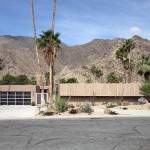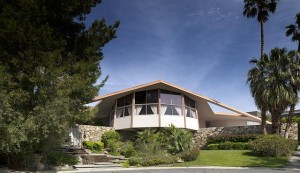Palm Springs.
Somehow I feel ritzy, elite, just writing the name.
If you’ve ever seen a classic black-and-white Hollywood movie such as “Sunset Strip,” there’s almost certain to be a reference, if not a celluloid visit, to the “resort city to the stars.”
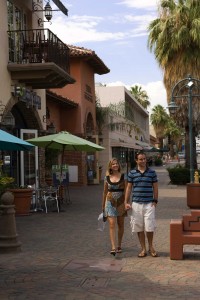
Pedestrian-friendly downtown Palm Springs has a Mediterranean feel. (Palm Springs Bureau of Tourism)
This California desert town of 48,000 or so people ranks with places such as Malibu and Beverly Hills in the L.A. area, Greenwich in Connecticut, Georgetown in Washington, D.C., Long Island’s “Gold Coast,” and another “Palm” — the one followed by “Beach” in Florida — among the nation’s aristocratic addresses.
But Palm Springs stands alone in one category: it is considered the “Mecca of Modernism” — the most concentrated collection of mid-twentieth century modern architecture on earth.
“Desert Modernism,” the style is sometimes called. It saved Palm Springs from the relentless onslaught of faux-Spanish, red-tiled houses that overtook much of the rest of Southern California.
To be fair, I know about as much about architecture as I do about, oh, Etruscan pottery. I couldn’t tell a finial from a newel post. And as you know if you’ve been with me for awhile, Carol’s and my tastes run toward cozy Victorian, not angular modernist.
But I respect what I read about Palm Springs’s ambitious architecture. I know what Carol and I saw: more glass walls and long, low roofs — and decadent swimming pools — than we’d ever seen in one place.
And I know what Robert Imber told us.
Imber, a Midwesterner who vacationed in Palm Springs before finally moving there, is now a passionate writer about, and preservationist of, the city’s Desert Modern treasures. He’s also guide to them, via minivan or, if you prefer, two-wheeled Segway “self-balancing transportation devices.” (We took the van.)
In a couple of sentences on an architectural Web site, Imber summed up the Palm Springs design revolution handily. “A tail-finned postwar America began gathering under [its] invigorating desert sun,” he wrote. “In rapid tempo, Hollywood’s ingénues and elite followed suit, discovering that Palm Springs was the perfect playground to frolic discreetly.”
And the perfect place to build unorthodox places in which to frolic.
Before I wade — quite possibly over my head — into more design talk, let’s consider the historical and physical backdrop.
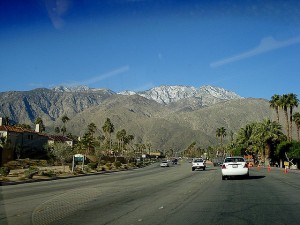
It can be toasty in Palm Springs and snowy in the distant San Jacinto Mountains. (JoeinSouthernCA, Flickr Creative Commons)
Palm Springs basks in the Coachella Valley desert, 177 km (111 miles) east of Los Angeles. Good-sized mountain ranges to the west, south, and north knock down almost every storm that would dare to move far inland off the Pacific Ocean, leaving Palm Springs warm and nearly bone dry. Only 15 centimeters (6 inches) of rain a year somehow fall, and all but 11 days annually, on average, are sunny.
Did I say warm? Make that roasting hot of a summer’s day — routinely 40 C° (105 F°) or hotter. It is that “dry heat” of which asthmatics and cactus lovers speak so fondly. But with nary a cloud in the sky to hold in the warmth, temperatures at night — even in the summertime — can plummet all the way to the low 20s C° (70s F°). Winter nights are nippy, but come spring and fall, temps are splendid.
There’s more groundwater in this area than in forlorn California desert spots such as Death Valley — enough of an oasis to have attracted a tribe of Cahuilla Indians called the Agua Caliente half a millennium ago. Their name in English — “Hot Water” — suggests that we’re not talking icy brooks, however.
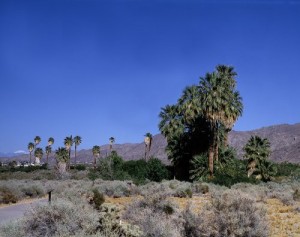
If you ignore the tiny structures at the top left, this is probably what the Coachella Valley looked a lot like to its first human visitors. (Carol M. Highsmith)
Nobody had to come along and plant palm seeds or dates or coconuts, or whatever it takes to make palm trees. (I know, I could look up what does.) Ancient groves dotted the desert before humans arrived. But the trees alone may not explain the town’s name. In a burst of unexplained exuberance, a little-known Spanish explorer is said to have called the area “The Palm of God’s Hand.”
The Spanish and, later, Mexicans who controlled California until 1850 took no lasting interest in the place. But eventually wealthy Anglos from the humid, chilly California coast began to see its potential as a winter retreat. The oldest remaining building in Palm Springs — a simple adobe built in 1884 for the first permanent white settler, San Francisco attorney John Guthrie McCallum — still stands.
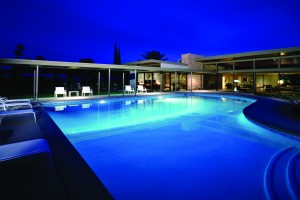
Frank Sinatra’s Twin Palms Estate home in Palm Springs is rented out for parties and the like. (Palm Springs Bureau of Tourism)
I’d bet just about anything that you’ve never heard of McCallum. But I’ll bet you know of some of the producers and stars who turned Palm Springs into “Hollywood’s Hideaway” in the century that followed. They included Howard Hughes, Lucille Ball, William Holden, Elizabeth Taylor, Steve McQueen, and three members of the mischievous “Rat Pack” — Frank Sinatra, Dean Martin, and Sammy Davis, Jr. Longtime residents Bob Hope and his wife, Delores, founded golf’s premier celebrity tournament there. Sonny Bono — the male half of singing Sonny and Cher, who was Palm Springs’s mayor from 1988 to 1992 — helped organize the highly regarded Palm Springs International Film Festival. And Albert Einstein, who generally steered clear of cameras, and legendary “Singing Cowboy” Gene Autry — an astute businessman who bought a hotel in town — lived in Palm Springs some, too.
Wealthy people eager to splurge on their desert retreats enticed some of America’s most eclectic, even eccentric, architects to the desert. “Palm Springs is not a city of architectural re-creations or approximations of previous eras,” wrote the National Trust for Historic Preservation in 2006, when it cited the desert resort as one of its Dozen Distinctive Destinations. “Instead, it is a remarkably intact and authentic expression of its architectural heritage.”
Not anything frou-frou, I would remind you. Stark, protruding, even cantilevered Desert Modern, where structure and unconventional form trump neoclassical frills.
Or as Robert Imber puts it, like Hollywood’s smart set, “Businesses and winter ‘snowbirds,’ too, commissioned then-all-new concepts in contemporary design.”
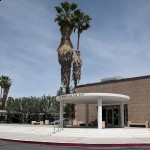
No doubt Albert Frey was making a statement with his design of city hall, but I haven’t a clue what it might be. Nice palms, though. (Carol M. Highsmith)
Inspired by the aesthetics of the German Bauhaus — I’m straying past my comfort zone here — architects such as Albert Frey, who had studied with famed urban designer Le Courbusier in Paris, designed Palm Springs’s city hall, the airport terminal, and the aptly-titled Movie Colony Hotel. Frey and others placed boulders, water features, and mountain backdrops into the hearts of their designs. They expected that sunset tableaus would be enjoyed to the fullest over drinks, right from the living room.
George and Robert Alexander, a father-son, Los Angeles-based developer team, delivered the dream of the stylish good life to the masses. Or if not the masses, the crust below the upper one. They created highly functional, low-slung, relatively affordable tracts of houses out of all kinds of materials, such as concrete, that had theretofore been anything but fashionable.
“Tiki-martini,” some wag described the Alexanders’ style.
Robert Alexander’s own boomerang-shaped! home, built in 1962, was featured in Look magazine as the “House of Tomorrow.” It was also the house of “the King” — crooner Elvis Presley and his girlfriend, Priscilla Beaulieu — for about a year. On May 1, 1967, they snuck out of it in the middle of the night, jetted off to Las Vegas, and were married in a private ceremony at the Aladdin Hotel, before returning to what is now called the “Elvis Honeymoon Hideaway.”
The house, now the most-visited and -photographed spot in Palm Springs, is the venue for “Elvis birthday celebrations” and “Elvis Honeymoon Weekend poolside concerts” that draw quite a throng. People were lined up in the heat outside the day Carol and I got a tour.
There is much more daring work around, however.
In 1936 — two years before Palm Springs would be incorporated as a city, Los Angeles architects Adrian Wilson and Eric Webster designed a “streamline moderne” hillside house that became known as “The Ship of the Desert.” Later destroyed in a fire, it was faithfully restored by its owners.
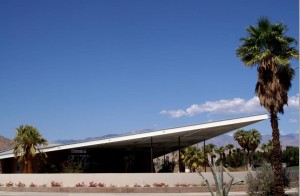
I toyed with the idea of showing you a vintage photo of the Tram Way gas station itself. But it looked pretty much the same, only shabbier than the current visitor center. (Palm Springs Bureau of Tourism)
In 1963, Albert Frey designed what today is one of the most famous gas stations in the nation. The Tram Way gas station, featuring a long, flat, angled roof that gives the place the look of a trapdoor opened slightly, is now the city’s visitor center.
Of the St. Theresa Catholic Church, designed by one of its parishioners, architect William Cody, Robert Imber said, “It is one of the most important and iconic pieces of our valley’s architecture. It’s magnificent from the exterior, whether it’s a bright, articulated morning or late afternoon. And once you experience the inside, it completely transforms you. The feeling of it, the lighting of it — it just transposes you to another place.”
Seems that he likes it.
Imber and writer Allison Engel ladle architectural innovations into a timeline of Palm Springs modern architecture, that, even without photos, gives you the idea that something quite out of the ordinary was going on in the desert. They mention “innovative ‘slip-form’ concrete,” “tranquil ‘layered leaf’ roof,” “spaceship-like second story,” “floating upper level,” “a superior example of Googie style” (Googie style?!), “elegant floating truss of Douglas fir inverted on three steel columns,” and “floating concrete plinth.”
There was a lot of “floating” going on in Palm Springs, apparently, and not just in the pool.
Thanks in part to the Alexanders, people of fairly ordinary means — especially retirees — moved into Palm Springs in the late 1970s and beyond. They turned the town from what Robert Imber has called a “sleepy seasonal village for affluent snowbirds” into a vibrant community in which businesses and hotels that were once shut tight each July and August stay open all summer.
It may not be the “Palm of God’s Hand,” but sun-kissed Palm Springs is no hideaway any more, either.
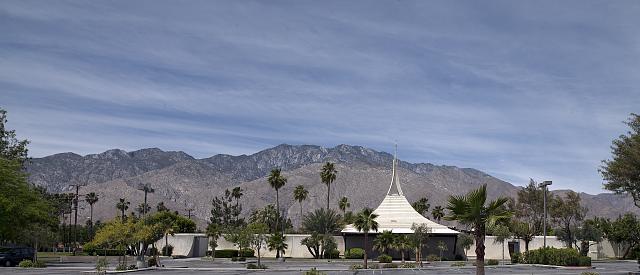
I’ll say this. St. Theresa’s doesn’t look like any other Roman Catholic Church I’ve seen. Interesting, though. (Carol M. Highsmith)
Ted's Wild Words
These are a few words from this posting that you may not know. Each time, I'll tell you a little about them and also place them into a cumulative archive of "Ted's Wild Words" in the right-hand column of the home page. Just click on it there, and if there's another word that you'd like me to explain, just ask!
Forlorn. Wretched, pitiful, hopeless.
Ingénue. A naïve, innocent girl or young woman — especially an actress who plays one.

